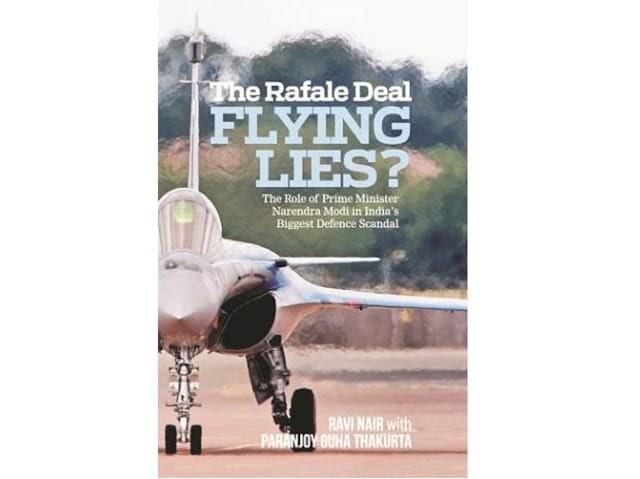
Parrikar, the savvy politician, was careful to credit Modi, praising the purchase as “a great decision made by Prime Minister Narendra Modi on better terms”.
Stealing lies: the Rafale agreement
Authors: Ravi Nair with Paranjoy Guha Thakurta
Editor: Paranjoy, 2022
pages: 532
Price: Rs 795/-
As the 2019 legislative elections approached, the so-called “Rafale scandal” made political headlines. The opposition, led by Congress Party leader Rahul Gandhi, has mounted a high-profile campaign accusing Prime Minister Narendra Modi of corruption and mismanagement in the purchase of medium fighters for the Indian Air Force (IAF) . TV news channels repeatedly debated whether the purchase of 36 Rafale fighters from French aerospace giant Dassault for a whopping 7.8 billion euros was in line with the rules; or if Modi had sacrificed the interests of the IAF to allow Anil Ambani and his business empire to enrich themselves through offsets, namely the construction of Rafale fighter parts in India. The debate eventually lost momentum, and by the time the votes were cast, it died down completely. But not for Ravi Nair and Paranjoy Guha Thakurta, the two authors of this book – The Rafale Deal: Flying Lies – who stubbornly stayed the course and eventually produced a compendium of the subject, analyzing the Rafale deal from multiple angles.
Their work will prove invaluable to future students of Indian Defense Procurement.
An important contextual aspect that the authors highlight is the IAF’s long-standing love affair with Dassault fighter jets. Since 1953, the IAF has always had at least one Dassault fighter in its inventory, having successively flown the Ouragan, the Mystere and the Mirage 2000. The IAF continues to fly the last of them, even as the IAF and the French company Thales are extending the life of the fleet with advanced avionics. In August 2000, after the Mirage 2000 had proven itself in the Kargil conflict, the IAF offered to acquire six squadrons (126 fighters) of Mirage 2000s, built in India after the transfer of the Mirage 2000 factory from France . In March 2001, the IAF resubmitted the proposal, arguing that the Mirage 2000 was more cost effective than the technologically superior Rafales and Eurofighter Typhoons, both of which would remain underutilized as the IAF’s requirement was for one aircraft smaller. New Delhi rejected this proposal in June 2001, as it was a single-vendor acquisition. After getting its fingers burned in the Tehelka tapes scandal, the government instead ordered a Defense Procurement Procedure (DPP)-compliant tender.
In December 2001, the IAF submitted the proposal for the third time, this time suggesting that the acquisition be considered a repeat purchase. In 2003, the IAF declared the Mirage 2000 the best option: similar to the Rafale, Eurofighter and Gripen, but less expensive. Dassault even offered to provide the Mirage 2000 as a single source through an Intergovernmental Agreement (IGA) between the two governments. After deliberating for a year, the MoD rejected the IAF’s proposal and ordered a competitive tender. The dice were cast and, in 2004, the IAF launched a global call for tenders for 126 fighters: the Medium Multi-Role Combat Aircraft (MMRCA).
The authors vividly recount how Prime Minister Narendra Modi decided to abandon the tender for 126 MMRCAs and instead purchase 36 fully-built Rafales, leaving Defense Minister Manohar Parrikar to hold the baby. A week before Modi left for a nine-day tour of France, Germany and Canada, Parrikar was summoned to the Prime Minister’s Office (PMO). There, Mr. Modi revealed that he and French President Francois Hollande would announce the acquisition of 36 Rafales. Mr Modi has tasked Parrikar with handling the media and answering the inevitable questions until he returns from his trip. Over the next fortnight, Parrikar fought on behalf of his Prime Minister, defending a decision he neither understood nor approved of, which was taken over his head and that his senior Ministry of Defense bureaucrats had warned him that it would be difficult to defend.
Parrikar, a savvy politician, never acknowledged a single role in the decision to replace the 126 MMRCA deal with the purchase of 36 Rafales. Instead, he was careful to credit Modi, hailing the purchase as “a great decision taken by Prime Minister Narendra Modi on better terms”. [than negotiated earlier.]”
Inevitably, the book focuses on what India paid for the fully-built 36 Rafales and how that compares to the price the MoD’s negotiating committee had set. In Doordarshan on April 13, 2015, Parrikar said, “When you talk about 126 [Rafales] this becomes a purchase of around Rs 90,000 crore”, or Rs 715 crore per fighter, all costs included. Taking raw numbers, the government paid 7.8 billion euros (58,000 crore rupees), which equates to 1,600 crore rupees per plane, more than double the price quoted by Parrikar on Doordarshan.
To be fair, the 2016 contract for 36 Rafale includes items that were not in the 126 MMRCA tender — including a superior weapons package and performance-based logistics (PBL) that requires 75% combat readiness at all times. Even deducting 2.8 billion euros [for the weapons and PBL] from the negotiated cost of €7.8 billion, the price of €5 billion puts the price of each Rafale at over Rs 1,000 crore.
The book is fully indexed and footnoted, which guarantees it the status of a reference work. There is also an excellent 44-page interview, in which one of the main protagonists of the Rafale contract, Air Marshal Raghunath Nambiar, answers a series of questions that cover practically all dimensions of decision-making in this market. . That alone makes the book an interesting read.






